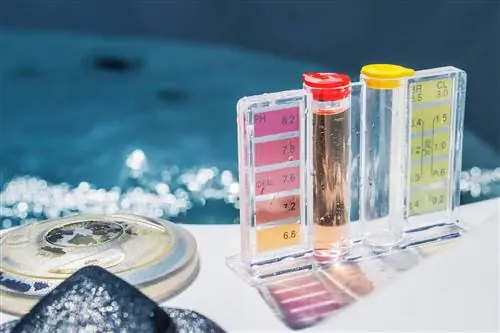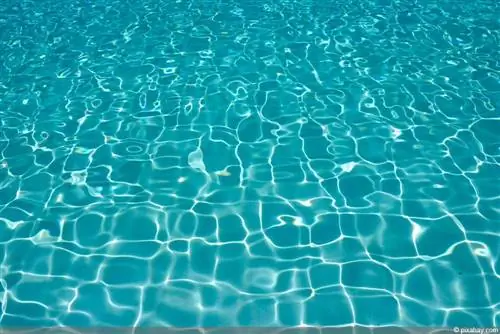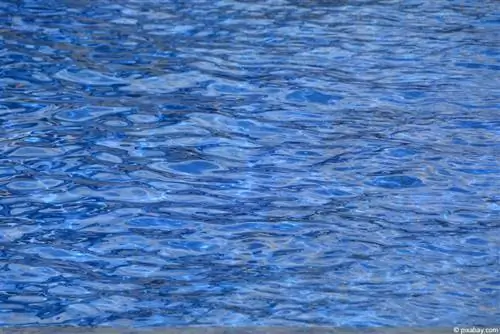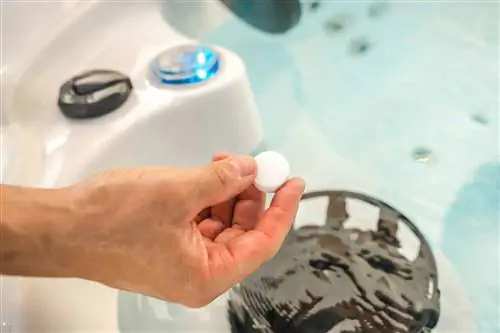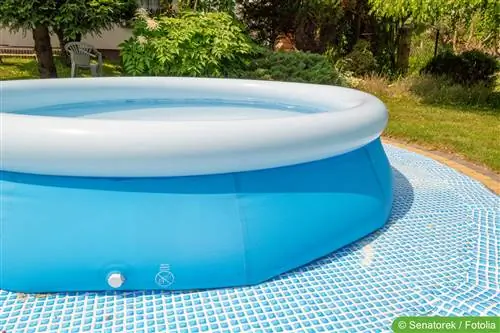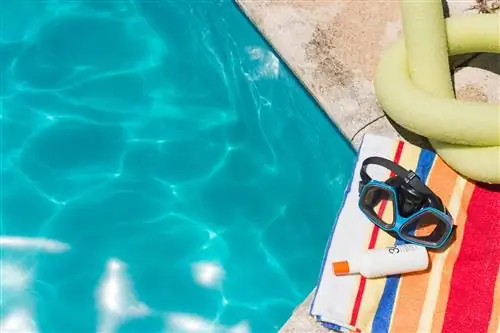- Author admin [email protected].
- Public 2023-12-17 03:39.
- Last modified 2025-01-24 12:45.
Is the chlorine level in the pool too high and swimming is not possible? Then good advice doesn't have to be expensive, because the chlorine levels can be easily reduced in several ways and thus brought into the optimal range.
Chlorine values explained
Proper pool care includes aiming for and maintaining the correct chlorine level. The following areas are important:
- less than 0.5 milligrams per liter is considered too low
- 0.5 to 1.0 milligrams per liter is considered the optimal range
- from 1.5 milligrams per liter the value is considered increased
- from 10 milligrams per liter are significantly increased
There is no upper limit for the private sector. Even 10 milligrams per liter is used in public swimming pools, for example, if they are heavily used. Red eyes, very dry skin and respiratory problems can be the consequences of such a high concentration. It is therefore better to stay in the optimal range.
Keep patience
Chlorine is used up in the pool water and evaporates. The content therefore decreases over time if the supply is interrupted, on its own and without any action. Crucial points for a quick reduction are:
- flying in or registered dirt
- high temperatures
- UV radiation
With slightly to strongly elevated values of 2.0 to a maximum of 10.0 milligrams per liter, the chlorine value can drop to the optimum within a few days. No intervention is necessary.
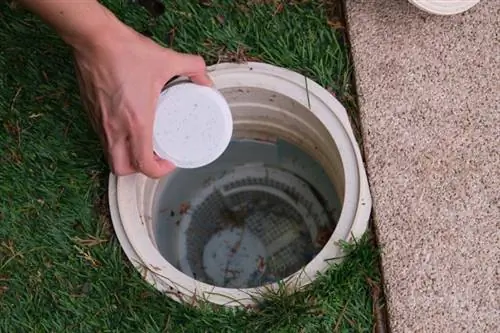
Remove cover
Since UV radiation, temperature and dirt play a crucial role in consuming chlorine and lowering the level in the pool water, the cover should initially be left off if the value is too high. Dust, sun and evaporation accelerate the subsidence.
Usage
As long as the chlorine value is only slightly increased, the pool can usually continue to be used without any problems. A maximum value of 10 milligrams per liter serves as a guide.
Sensitive people should avoid this. Possible consequences include irritation of the:
- Respiratory system
- Eyes
- Skin
- Mucous membrane
For everyone else, bathing is a good way to quickly reduce chlorine levels. Sunscreen, dander, dust and other particles that are introduced react with the chlorine and use it up more quickly.
Check pH value
Chlorine is only used when the pH of the water is in the correct range. Otherwise it cannot become active and the value remains too high. 7.0 to 7.4 are optimal. If this is not achieved in the pool water, an adjustment must first be made. The chlorine value then drops on its own.
Tip:
If the water smells strongly of chlorine but still becomes cloudy or discolored, the incorrect pH value is usually responsible. Regular inspection should therefore be part of pool maintenance.
Water exchange
If safe swimming in the pool is not possible due to the chlorine content being too high, a partial water replacement can make sense. How much the chlorine value drops depends on various factors. These are:
- Exchange quantity
- pH value of the supplied water
- Cleanliness
- Temperature
- Cause of overchlorination
Therefore, it is not possible to accurately predict whether the chlorine level will decrease by 25 percent if 25 percent of the water is replaced. So multiple measurements are required here.
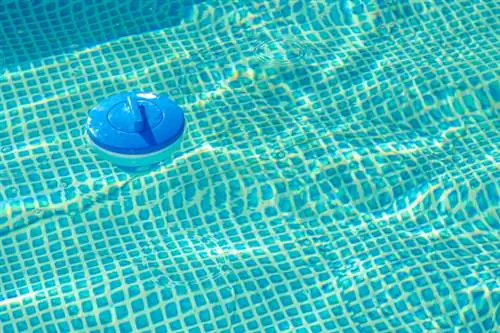
Find the cause
There is always a cause for a chlorine value that is too high in the pool. This should be found and stopped to avoid repeated over-chlorination. This saves effort and time. In addition, the budget and the environment are protected. Possible reasons for a surprisingly high chlorine content are:
- wrong setting for automatic chlorination
- wrong pH value
- Error when measuring or calculating
- temperature too low
- too short intervals during chlorination
Regular measurement of chlorine and pH values can help to better adjust the dosage and should therefore be part of the basics of pool care.
Tip:
If the cause is an overdose caused by automatic chlorination, this should be stopped immediately and then adjusted correctly. Adjustments are necessary for other triggers.
Introduce chlorine neutralizer
So-called chlorine neutralizers are special agents that combine with the chlorine and thereby make it inactive. They should only be used if there is very strong overchlorination of more than 10 milligrams per liter and the cause has already been found and, if necessary, corrected and the other measures have not been successful. The resources only make sense if you absolutely want the pool to be usable again as quickly as possible.
Tip:
When it comes to dosage, it's worth starting with very small amounts and measuring the value again and again. Because once the neutralizer has been added, adjusting it by subsequently adding chlorine is time-consuming and difficult.
Frequently asked questions
Why are chlorine levels higher in swimming pools?
Because usage is much higher here. So more chlorine is needed to neutralize the amount of particles and maintain hygienic values.
How quickly does the chlorine level drop?
Exact information about the duration is not possible as it depends on several factors. High temperatures, direct sunlight and omitting the cover promote falling chlorine levels as well as extensive use.

